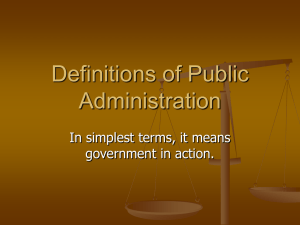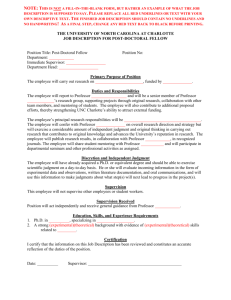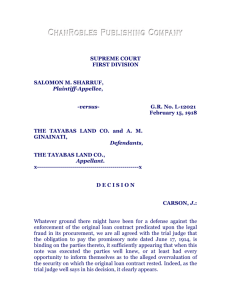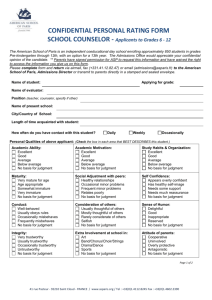USING REEVES TO TEACH SUMMARY JUDGMENT
advertisement
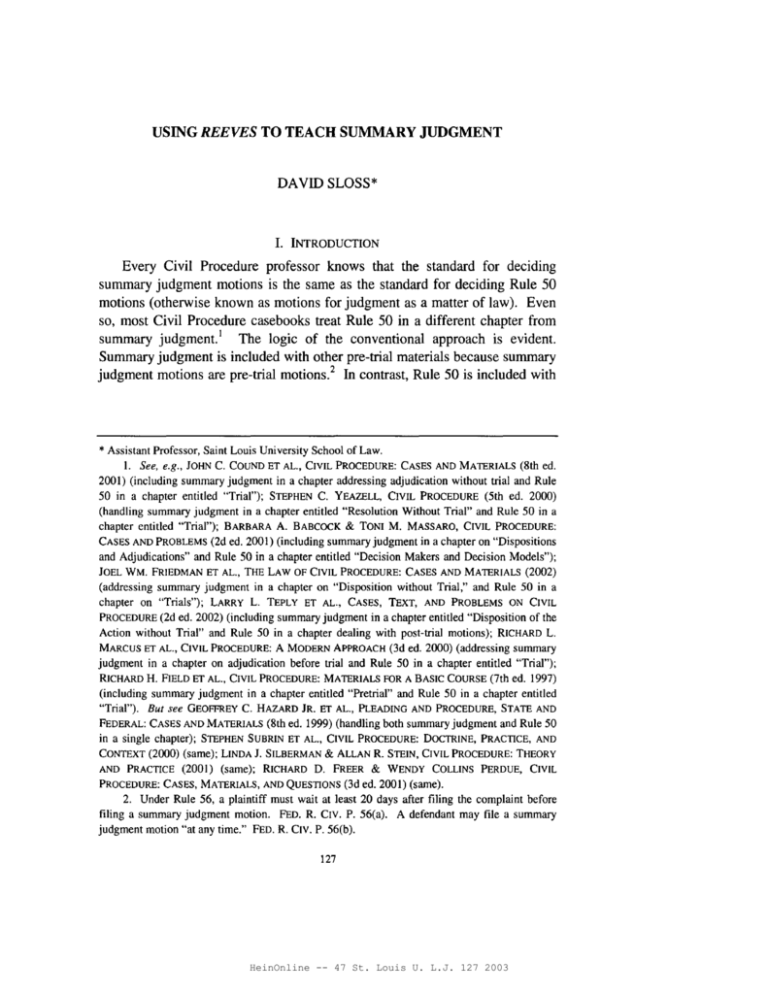
USING REEVES TO TEACH SUMMARY JUDGMENT DAVID SLOSS* I. INTRODUCTION Every Civil Procedure professor knows that the standard for deciding summary judgment motions is the same as the standard for deciding Rule 50 motions (otherwise known as motions for judgment as a matter of law). Even so, most Civil Procedure casebooks treat Rule 50 in a different chapter from summary judgment. 1 The logic of the conventional approach is evident. Summary judgment is included with other pre-trial materials because summary judgment motions are pre-trial motions. 2 In contrast, Rule 50 is included with * Assistant Professor, Saint Louis University School of Law. 1. See, e.g., JOHN C. COUND ET AL., CIVIL PROCEDURE: CASES AND MATERIALS (8th ed. 2001) (including summary judgment in a chapter addressing adjudication without trial and Rule 50 in a chapter entitled "Trial"); STEPHEN C. YEAZELL, CIVIL PROCEDURE (5th ed. 2000) (handling summary judgment in a chapter entitled "Resolution Without Trial" and Rule 50 in a chapter entitled "Trial"); BARBARA A. BABCOCK & TONI M. MASSARO, CIVIL PROCEDURE: CASES AND PROBLEMS (2d ed. 2001) (including summary judgment in a chapter on "Dispositions and Adjudications" and Rule 50 in a chapter entitled "Decision Makers and Decision Models"); JOEL WM. FRIEDMAN ET AL., THE LAW OF CIVIL PROCEDURE: CASES AND MATERIALS (2002) (addressing summary judgment in a chapter on "Disposition without Trial," and Rule 50 in a chapter on "Trials"); LARRY L. TEPLY ET AL., CASES, TEXT, AND PROBLEMS ON CIVIL PROCEDURE (2d ed. 2002) (including summary judgment in a chapter entitled "Disposition of the Action without Trial" and Rule 50 in a chapter dealing with post-trial motions); RICHARD L. MARCUS ET AL., CIVIL PROCEDURE: A MODERN ApPROACH (3d ed. 2000) (addressing summary judgment in a chapter on adjudication before trial and Rule 50 in a chapter entitled "Trial"); RICHARD H. FIELD ET AL., CIVIL PROCEDURE: MATERIALS FOR A BASIC COURSE (7th ed. 1997) (including summary judgment in a chapter entitled "Pretrial" and Rule 50 in a chapter entitled "Trial"). But see GEOFFREY C. HAZARD JR. ET AL., PLEADING AND PROCEDURE, STATE AND FEDERAL: CASES AND MATERIALS (8th ed. 1999) (handling both summary judgment and Rule 50 in a single chapter); STEPHEN SUBRIN ET AL., CIVIL PROCEDURE: DOCTRINE, PRACTICE, AND CONTEXT (2000) (same); LINDA J. SILBERMAN & ALLAN R. STEIN, CIVIL PROCEDURE: THEORY AND PRACTICE (2001) (same); RICHARD D. FREER & WENDY COLLINS PERDUE, CIVIL PROCEDURE: CASES, MATERIALS, AND QUESTIONS (3d ed. 2001) (same). 2. Under Rule 56, a plaintiff must wait at least 20 days after filing the complaint before filing a summary judgment motion. FED. R. CIV. P. 56(a). A defendant may file a summary judgment motion "at any time." FED. R. CIV. P. 56(b). 127 HeinOnline -- 47 St. Louis U. L.J. 127 2003 128 SAINT LOUIS UNIVERSITY LA W JOURNAL [Vol. 47:127 other trial materials because motions for judgment as a matter of law must be brought during or immediately after trial. 3 I teach Rule 50 and summary judgment together in the same section of the course to emphasize the similarities of the two procedures. One benefit of this approach is that the professor can use the Supreme Court's decision in Reeves v. Sanderson Plumbing Products, Inc.,4 to help clarify ambiguities in the Celotex trilogy. The Celotex trilogy--comprising Celotex Corp. v. Catrett,5 Anderson v. Liberty Lobby, Inc. 6 and Matsushita Electric Industrial Co. v. Zenith Radio Corp.7-is the Supreme Court's last major pronouncement on summary judgment. In certain respects, the trilogy is a poor tool for teaching summary judgment because, as the dissenters noted at the time, Matsushita and Anderson make "confusing and inconsistent statements about the appropriate standard for granting summary judgment,"S and send "conflicting signals to trial courts and reviewing courts which must deal with summary judgment motions on a day-to-day basis.,,9 In Reeves, the Supreme Court clarified the standard governing Rule 50 1O motions. The Court also affirmed that "the standard for granting summary judgment 'mirrors' the standard for judgment as a matter of law, such that 'the inquiry under each is the same.",ll Civil Procedure casebooks generally either omit Reeves entirely,12 or include Reeves in the section on Rule 50 motions. 13 Indeed, I have not found a single Civil Procedure casebook that includes Reeves in the section on summary judgment. This essay suggests that Reeves is very helpful for teaching summary judgment, despite the fact that Reeves is a Rule 50 case, because Reeves does a much better job than the Celotex trilogy of clarifying the standard that governs both summary judgment motions and Rule 50 motions. 3. A party may move for judgment as a matter of law under Rule 50(a) after "a party has been fully heard on an issue," but "before submission of the case to the jury." FED. R. CIY. P. 50(a). A renewed motion for judgment as a matter of law under Rule 50(b) must be filed "no later than 10 days after entry of judgment." FED. R. CiY. P. 50(b). 4. 530 U.S. 133 (2000). 5. 477 U.S. 317 (1986). 6. 477 U.S. 242 (1986). 7. 475 U.S. 574 (1986). 8. Id. at 599 (White, J., dissenting). 9. Anderson, 477 U.S. at 265 (Brennan, J., dissenting). 10. See Reeves. 530 U.S. at 149-51. 11. Id. at 150 (quoting Anderson, 477 U.S. at 250-51). 12. See, e.g., COUND ET AL., supra note 1; HAZARD ET AL., supra note 1 and 2001 Supp.; YEAZELL, supra note 1; SUBRIN ET AL., supra note 1; FIELD ET AL., supra note 1 and 2002 Supp.; MARCUS ET AL., supra note I. 13. See. e.g., FRIEDMAN ET AL., supra note I, at 686-89; BABCOCK & MASSARO, supra note I, at 729-40; FREER & PERDUE, supra note I, at 562, 564; TEPLY ET AL., supra note I, at 1025; SILBERMAN & STEIN, supra note I, at 714. HeinOnline -- 47 St. Louis U. L.J. 128 2003 2003] USING REEVES TO TEACH SUMMARY JUDGMENT II. 129 THE CELOTEX TRILOGY Rule 56 of the Federal Rules of Civil Procedure concerns summary judgment. Rule 56(c) provides that summary judgment shall be granted if the evidence shows "that there is no genuine issue as to any material fact and that the moving party is entitled to a judgment as a matter of law.,,14 Rule 56(e) adds: "When a motion for summary judgment is made and supported as provided in this rule, an adverse party may not rest upon the mere allegations or denials of the adverse party's pleading, but the adverse party's response ... must set forth specific facts showing that there is a genuine issue for trial.,,15 The Supreme Court has not squarely addressed the proper interpretation and application of Rule 56 since it decided the Celotex trilogy in 1986. 16 The trilogy addresses two distinct aspects of the law of summary judgment. Celotex itself is addressed primarily to litigators. It provides a gloss on Rule 56(e), focusing on the nature of the evidence that parties must present when they file a summary judgment motion, or respond to such a motion. In contrast, Anderson and Matsushita are addressed primarily to judges. They provide a gloss on Rule 56(c), focusing on the methodology that courts should employ in deciding whether the evidence presented by the parties creates a "genuine issue as to any material fact.',I? Celotex is pedagogically valuable because Justice Brennan's dissenting opinion in Celotex provides a clear, authoritative statement of the principles that guide litigators in deciding what evidence to present in support of or in 18 opposition to a summary judgment motion. Civil Procedure professors generally agree on the pedagogical value of Celotex, as evidenced by the fact that virtually every significant Civil Procedure casebook includes Celotex as a • 19 mam case. 14. FED. R. CIV. P. 56(c). 15. FED. R. CIV. P. 56(e). 16. Celotex Corp. v. Catrett, 477 U.S. 317 (1986); Anderson v. Liberty Lobby, Inc., 477 U.S. 242 (1986); Matsushita Elec. Indus. Co. v. Zenith Radio Corp., 475 U.S. 574 (1986). 17. FED. R. CIV. P. 56(c). 18. In Celotex, the court of appeals ruled that the defendant's "summary judgment motion was rendered 'fatally defective' by the fact that petitioner 'made no effort to adduce any evidence ... to support its motion.''' Celotex, 477 U.S. at 321 (quoting D.C. Circuit opinion). In the Supreme Court, Justice Rehnquist, writing for the majority, and Justice Brennan, writing for the dissent, agreed that the D.C. Circuit's reasoning was flawed because the defendant was not required to adduce any evidence to support its summary judgment motion. See id. at 322-23 (majority opinion); id. at 330-34 (Brennan, J., dissenting). Justice Brennan's dissent is more pedagogically useful, though, because it provides a more complete explanation as to why the defendant was not required to adduce any evidence in support of its motion. 19. See, e.g., COUND ET AL., supra note I, at 925-31; YEAZELL, supra note I, at 630-34; FRIEDMAN ET AL., supra note I, at 496-507; TEPLY ET AL., supra note I, at 904-09; MARCUS ET AL., supra note I, at 414-23; FIELD ET AL., supra note I, at 650-57; HAZARD ET AL., supra note I, at 1027-36; SUBRIN ET AL., supra note I, at 485-94; SILBERMAN & STEIN, supra note I, at 689- HeinOnline -- 47 St. Louis U. L.J. 129 2003 130 SAINT LOUIS UNIVERSITY LA W JOURNAL [Vo1. 47:127 In contrast, the pedagogical value of Anderson and Matsushita is more questionable, as evidenced by the fact that casebook authors tend to offer more cursory coverage of those cases. 20 It is settled law that an issue is "genuine" for purposes of Rule 56(c) if "a reasonable jury could return a verdict for the nonmoving party.,,21 However, Anderson and Matsushita pose pedagogical difficulties because the majority opinions in each case appear to support two contrasting methods for applying the "no genuine issue" standard in Rule 56(c). As Justice Brennan noted in his dissent in Anderson, the majority opinion "is replete with boilerplate language to the effect that trial courts are not to weigh evidence when deciding summary judgment motions.,,22 For example, the majority in Anderson said: "Credibility determinations, the weighing of the evidence, and the drawing of legitimate inferences from the facts are jury functions, not those of a judge, whether he is ruling on a motion for summary judgment or for a directed verdict.',23 Similarly, the majority opinion in Matsushita said: "On summary judgment the inferences to be drawn from the underlying facts . . . must be viewed in the light most favorable to the party opposing the motion.',24 The principle that judges are supposed to view the evidence in the light most favorable to the non-moving party reinforces the idea that the weighing of evidence is a jury function, not a judicial function. However, the majority opinions in both Anderson and Matsushita also contain statements that appear to require judges to weigh the evidence when deciding summary judgment motions. For example, in Anderson, the majority opinion stated: "When determining if a genuine factual issue ... exists. . . a trial judge must bear in mind the actual quantum and quality of proof necessary to support liability. . .. [T]here is no genuine issue if the evidence presented in the opposing affidavits is of insufficient caliber or quantity to allow a rational finder of fact" to render a verdict in favor of the non-moving party. 25 Unfortunately, the Court failed to explain how a trial judge is expected to 700; FREER & PERDUE, supra note 1, at 546-54. But see BABCOCK & MASSARO, supra note 1, at 568-71 (including Celotex as a note case). 20. Although most of the eleven casebooks cited in the previous footnote reference Matsushita in notes, none of them includes Matsushita as a main case. Only three of the eleven casebooks include Anderson as a main case. See COUND ET AL., supra note 1, at 934-40; HAZARD ET AL., supra note 1, at 1037-45; FREER & PERDUE, supra note 1, at 532-41. 21. Anderson, 477 U.S. at 248. 22. Id. at 265 (Brennan, J., dissenting). 23. Id. at 255. See also id. at 249 ("[Alt the summary judgment stage the judge's function is not himself to weigh the evidence and determine the truth of the matter but to determine whether there is a genuine issue for tria1."). 24. Matsushita Elec. Indus. Co. v. Zenith Radio Corp., 475 U.S. 574, 587 (1986). 25. Anderson, 477 U.S. at 254. HeinOnline -- 47 St. Louis U. L.J. 130 2003 2003] USING REEVES TO TEACH SUMMARY JUDGMENT 131 determine whether evidence is of sufficient "caliber or quantity" without . h'mg the eVl'dence. 26 welg Similarly, in Matsushita, the Court says: "If the factual context renders respondents' claims implausible, ... respondents must offer more persuasive evidence to support their claims than would otherwise be necessary.',27 This appears to require judges to evaluate the persuasiveness of the evidence, a "weighing" function traditionally delegated to the jury, not the judge. Matsushita also said that, to defeat a summary judgment motion, the nonmoving party must show that a particular inference "is reasonable in light of the competing inferences.',28 But the Court failed to resolve the tension between the principle that a judge should determine whether an inference is "reasonable in light of the competing inferences," and the seemingly contradictory principle that "the inferences to be drawn from the underlying facts ... must be viewed in the light most favorable to the party opposing the motion.',29 In sum, the majority opinions in both Anderson and Matsushita provide support for both a "no weighing" method and a "weighing" method of applying the "no genuine issue" standard embodied in Rule 56(c). The stark contrast between the "weighing" and "no weighing" methods poses a pedagogical problem for Civil Procedure teachers. One approach to teaching summary judgment is to suggest to students that Anderson and Matsushita have sown confusion in the lower courts, and that lower courts actually apply two incompatible methodologies in summary judgment cases. This approach has the virtue of being descriptively accurate: lower courts do, in fact, apply both the "weighing" and "no weighing" methods. 3o Unfortunately, though, just as Anderson and Matsushita have sown confusion in the lower courts, this pedagogical approach leaves first-year Civil Procedure students hopelessly 26. Justice Brennan makes essentially the same point in his dissent in Anderson: I simply cannot square the direction that the judge "is not himself to weigh the evidence" with the direction that the judge also bear in mind the "quantum" of proof required and consider whether the evidence is of sufficient "caliber or quantity" to meet that "quantum." I would have thought that a determination of the "caliber and quantity," Le., the importance and value, of the evidence in light of the "quantum," Le., amount "required," could only be performed by weighing the evidence. Id. at 266 (Brennan, J., dissenting). 27. Matsushita, 475 U.S at 587. 28. [d. at 588. 29. [d. at 587 (quoting United States v. Diebold, Inc., 369 U.S. 654, 655 (1962)). 30. Compare Nidds v. Schindler Elevator Corp., 113 F.3d 912, 916-19 (9th Cir. 1997) (applying the weighing method, and affirming a grant of summary judgment for defendant in an age discrimination case because plaintiffs evidence was "not sufficiently probative"), with id. at 921-22 (Noonan, J., dissenting) (applying the no weighing method, and criticizing the majority for "denying the litigants their constitutional right to trial by their peers"). HeinOnline -- 47 St. Louis U. L.J. 131 2003 132 SAINT LOUIS UNIVERSITY fA W JOURNAL [Vol. 47:127 confused about how a court is supposed to determine whether there is a "genuine issue" for trial. III. REEVES The Supreme Court's decision in Reeves v. Sanderson Plumbing Products, Inc?l provides much needed clarification for courts and Civil Procedure students about how to reconcile the conflict between the weighing and no weighing methods. Reeves, it should be noted, is not a summary judgment case. The lower court decided Reeves after trial on the basis of a Rule 50(b) motion for judgment as a matter of law?2 However, as the Court affirmed in Reeves, "the standard for granting summary judgment 'mirrors' the standard for judgment as a matter of law, such that 'the inquiry under each is the same.' ,,33 Therefore, the Reeves Court's clarification of the standard governing Rule 50 motions applies equally to summary judgment motions. Given the importance of the case, it is worth quoting Reeves at length: The Courts of Appeals have articulated differing formulations as to what evidence a court is to consider in ruling on a Rule 50 motion. Some decisions have stated that review is limited to that evidence favorable to the nonmoving party, while most have held that review extends to the entire record, drawing all reasonable inferences in favor of the non-movant. On closer examination, this conflict seems more semantic than real. . .. In Wilkerson, we stated that "in passing upon whether there is sufficient evidence to submit an issue to the jury we need look only to the evidence and reasonable inferences which tend to support the case of' the nonmoving party. But subsequent decisions have clarified that this passage was referring to the evidence to which the trial court should give credence, not the evidence that the court should review. In the analogous context of summary judgment under Rule 56, we have stated that the court must review the record "taken as a whole." ... It therefore follows that, in entertaining a motion for judgment as a matter of law, the court should review all of the evidence in the record. In doing so, however, the court must draw all reasonable inferences in favor of the nonmoving party, and it may not make credibility determinations or weigh the evidence.... Thus, although the court should review the record as a whole, it must disregard all evidence favorable to the moving party that the jury is not required to believe. That is, the court should give credence to the evidence favoring the nonmovant as well as that "evidence supporting the 31. 530 U.S. 133 (2000). 32. See id. at 138-39. See also FED. R. elv. P. 50(b). 33. Reeves, 530 U.S. at 150 (quoting Anderson v. Liberty Lobby, Inc., 477 U.S. 242, 250-51 (1986». HeinOnline -- 47 St. Louis U. L.J. 132 2003 2003] USING REEVES TO TEACH SUMMARY JUDGMENT 133 moving party that is uncontradicted and unimpeached, at least to the extent that that evidence comes from disinterested witnesses.,,34 This passage is the Supreme Court's clearest explanation of how trial court judges should approach summary judgment motions and Rule 50 motions. For the sake of analytic clarity, the methodology outlined in Reeves can be divided into five discrete steps: • First, the trial judge "should review all of the evidence in the record.,,35 • Second, the judge should divide the evidence into two categories: evidence favorable to the moving party and evidence favorable to the nonmoving party. • Third, the judge should further subdivide the evidence favorable to the moving party into two sub-categories: (a) evidence that is "uncontradicted and unimpeached [and]... from disinterested witnesses,,;36 and (b) evidence that is either contradicted, or impeached, or from an interested witness. • Fourth, the court should "disregard all evidence favorable to the moving party that the jury is not required to believe," but "give credence to the evidence favoring the nonmovant as well as that 'evidence supporting the moving party that is uncontradicted and unimpeached' [and] ... 'from disinterested witnesses.",3? In other words, for purposes of deciding a summary judgment motion or a Rule 50 motion, the judge must make three legally mandated presumptions: (l) that the jury will not believe any of the evidence favorable to the moving party that is either contradicted, or impeached, or from an interested witness; 38 (2) that the jury will believe all of the evidence 34. Id. at 149-51 (citations omitted). 35. Id. at ISO. 36. Id. at lSI (quoting 9A CHARLES ALAN WRIGHT & ARTHUR R. MILLER, FEDERAL PRACTICE AND PROCEDURE § 2529, at 299 (2d ed. 1995) [hereinafter WRIGHT & MILLER]). 37. Id. (quoting WRIGHT & MILLER at 299). 38. The language of Reeves leaves open the possibility that the judge could give credence to (i.e., presume the jury will believe) some evidence from interested witnesses that is uncontradicted and unimpeached. Whether this is proper depends, in part, on what is meant by the term "interested witness." When ruling on a summary judgment motion or a rule 50 motion, courts rarely give credence to evidence supporting the moving party that comes from a witness with a direct financial stake in the outcome of the case. However, if the term "interested witness" is construed more broadly, then there may be circumstances in which it is appropriate for a judge to give credence to the testimony of an interested witness. For example, if a company has a financial stake in the outcome of a case, but the company's employee does not, the employee might be considered an "interested witness" in some sense, but a court might still give credence HeinOnline -- 47 St. Louis U. L.J. 133 2003 134 SAINT LOUIS UNIVERSITY LA W JOURNAL [Vol. 47:127 favorable to the non-moving party; and (3) that the jury will believe all evidence favorable to the non-moving party that is uncontradicted, unimpeached, and from a disinterested witness. These three presumptions operationalize the traditional maxim that the judge must view the evidence "in the light most favorable to the party opposing the motion.,,39 • Fifth, having made the legally mandated presumptions, the judge should determine whether "a reasonable jury could return a verdict for the nonmoving party,,40 on the basis of the evidence the jury is presumed to believe. This requires the judge to determine whether it is legally permissible for the jury, relying exclusively on the evidence it is presumed to believe, to draw inferences that would support a verdict for the non-moving party.41 If the inferences necessary to support a verdict for the non-moving party are not legally permissible, then "there is no genuine issue as to any material fact and ... the moving party is entitled to judgment as a matter of law.,,42 The methodology outlined in Reeves, and elaborated herein, provides the key to reconciling the conflict between the "weighing" and "no weighing" methods of deciding summary judgment motions. In accordance with the Reeves approach, the judge assesses the "caliber,,43 of the moving party's evidence by determining which evidence is "uncontradicted and unimpeached ... [and] comes from disinterested witnesses.,,44 But the judge to the employee's testimony favoring the moving party, insofar as it is uncontradicted and unimpeached. In any event, the problem of interested witnesses-including how to define the term "interested witness," and when, if at all, to give credence to their testimony-is one of the key issues that Reeves leaves unresolved. 39. Matsushita Elec. Indus. Co. v. Zenith Radio Corp., 475 U.S. 574, 587 (1986) (quoting United States v. Diebold, Inc., 369 U.S. 654, 655 (1962». 40. Anderson v. Liberty Lobby, Inc., 477 U.S. 242, 248 (1986). 41. To understand the law of summary judgment properly, one must understand the distinction between permissible and impermissible inferences. Students often have difficulty with this concept, in part because procedural law requires courts to make the distinction, but does not tell courts how to apply the distinction. Courts must rely on a combination of logic and substantive law to apply the distinction in any given case. Although the Reeves framework presupposes that the distinction between permissible and impermissible inferences is critical, Reeves does not provide any guidance as to how to apply that distinction. 42. FED. R. CIV. P. 56(c). Rule 50 expresses the same standard in different language. See FED. R. CIV. P. 50(a)(I) ("If during a trial by jury a party has been fully heard on an issue and there is no legally sufficient evidentiary basis for a reasonable jury to find for that party on that issue, the court may determine the issue against that party and may grant a motion for judgment as a matter of law ...."). 43. Anderson, 477 U.S. at 254. 44. Reeves v. Sanderson Plumbing Prods., Inc., 530 U.S. 133, 151 (2000). HeinOnline -- 47 St. Louis U. L.J. 134 2003 2003] USING REEVES TO TEACH SUMMARY JUDGMENT 135 does not "weigh" the evidence because the judge does not evaluate conflicting evidence to determine which is more persuasive. Rather, the judge decides whether there is conflicting evidence, and if so, the judge makes the legally mandated presumption that, in the event of a conflict, the jury will believe the evidence that favors the non-moving party.45 Thus, in contrast to Anderson and Matsushita, Reeves explains how judges can and should assess the "caliber" of evidence without "weighing" the evidence. Reeves also helps resolve the apparent conflict between the statement that a judge should determine whether an inference is "reasonable in light of the competing inferences,,,46 and the statement that "the inferences to be drawn from the underlying facts ... must be viewed in the light most favorable to the party opposing the motion.,,47 In step five of the process outlined above, the judge evaluates the inferences favoring the non-moving party in light of the competing inferences drawn from the evidence favoring the moving party that is uncontradicted, unimpeached and from a disinterested witness. This process is consistent with the principle that the evidence must be viewed in the light most favorable to the non-moving party, because the judge "must disregard all evidence favorable to the moving party" that is contradicted, or impeached or from an interested witness. 48 IV. PEDAGOGY I teach summary judgment and Rule 50 together as a single unit. I start with Reeves, giving the students key excerpts, along with the five-step model presented above. I then direct students to apply the five-step model to a variety of actual and hypothetical cases. By working through the process of applying the model to a range of cases, the students gain a clear understanding of how to apply the legal standards in Rule 56(c) ("no genuine issue") and Rule 50(a) ("no legally sufficient evidentiary basis"). A simple hypothetical case illustrates the application of the model. Driver One (Dl) was heading north on a two-lane highway with one passenger. Driver Two (D2) was heading south on the same road with no passengers. The two cars collided. Both drivers died instantly. The passenger (P) survived, but sustained severe injuries. P sued D2's estate. P moved for partial summary judgment on the issue of D2's negligence. The record consists of the following evidence: 45. It bears emphasis that the Reeves methodology is consistent with traditional summary judgment principles in that the judge does not make credibility determinations. Rather, the judge makes legally mandated presumptions about what the jury will or will not believe. 46. Matsushita Elec. Indus. Co. v. Zenith Radio Corp., 475 U.S. 574, 588 (1986). 47. [d. at 587. 48. Reeves, 530 U.S. at 151. HeinOnline -- 47 St. Louis U. L.J. 135 2003 136 SAINT LOUIS UNIVERSITY LAW JOURNAL [Vol. 47:127 • A sworn affidavit, signed by P, stating that she saw D2's car cross the center line of the road just before the accident. • An expert report, submitted by P's expert, concluding on the basis of available physical evidence (skid marks, damage to the cars, etc.) that it is "more likely than not" that D2's car crossed the center line of the road. • Deposition testimony during which P's expert admitted that the physical evidence in the case was "inconclusive." The expert also admitted that P was paying him $300 per hour for his services. In accordance with the Reeves model, the judge would review all of the evidence and divide it into two categories. The affidavit and the expert report favor the moving party; the deposition testimony favors the non-moving party. The judge would disregard the affidavit on the grounds that it is from an interested witness. Hence, the key question is whether the expert report is either contradicted or impeached by the deposition testimony.49 If the court concludes that the expert report is uncontradicted and unimpeached, then the judge must presume that the jury will believe the expert report. The question then becomes whether it is legally permissible for the jury to draw inferences that would support a verdict for the non-moving party (D2). In this case, the non-moving party wants the jury to infer that D2 was not negligent. That inference is not legally permissible because the judge has made the presumption that the jury will believe P's expert report, and it is legally impermissible for a jury that believes the expert report to infer that D2 was not negligent. Therefore, if the court concludes that the expert report is uncontradicted and unimpeached, the motion for partial summary judgment should be granted. If, on the other hand, the court concludes that the expert report is either contradicted or impeached, then the judge must presume that the jury will not believe the expert report. Given the presumption that the jury will not believe either the expert report or P's affidavit (which is from an interested witness), the inference that D2 was not negligent is legally permissible because there is no evidence that the jury believes that would support the opposite inference 49. There are plausible arguments on both sides. D2 will argue that the conclusion contained in the expert report-that it is "more likely than not" that D2's car crossed the center line-is contradicted by the expert's admission that the physical evidence is "inconclusive." D2 will also argue that the expert's credibility is impeached by his admission that he is being paid for his services. P will counter that there is no contradiction between the expert report and the deposition testimony. P will also argue that the mere fact that the expert is being paid, without more, is not a legally sufficient basis to impeach his credibility. HeinOnline -- 47 St. Louis U. L.J. 136 2003 2003] USING REEVES TO TEACH SUMMARY JUDGMENT 137 (that D2 was negligent). Since the inference that D2 was not negligent is legally permissible, P's motion for partial summary judgment must be denied. HeinOnline -- 47 St. Louis U. L.J. 137 2003



